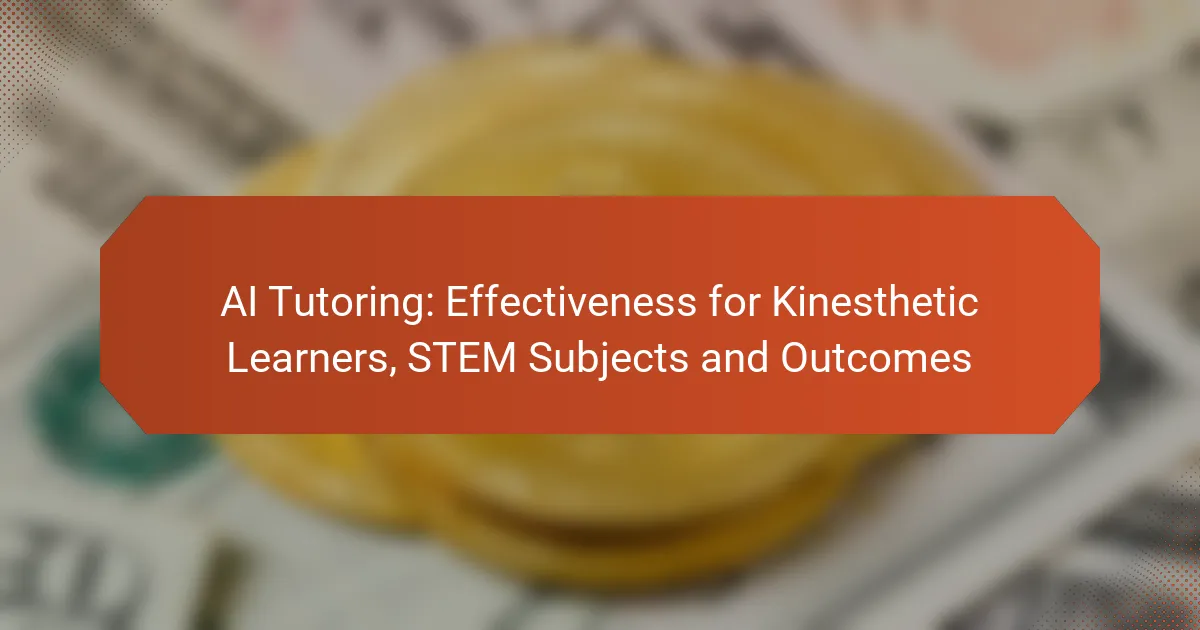AI tutoring has shown significant effectiveness for kinesthetic learners, particularly in STEM subjects, by offering tailored, hands-on experiences that align with their learning preferences. These platforms provide interactive content and personalized instruction, adapting to individual needs to enhance understanding and retention of complex concepts.
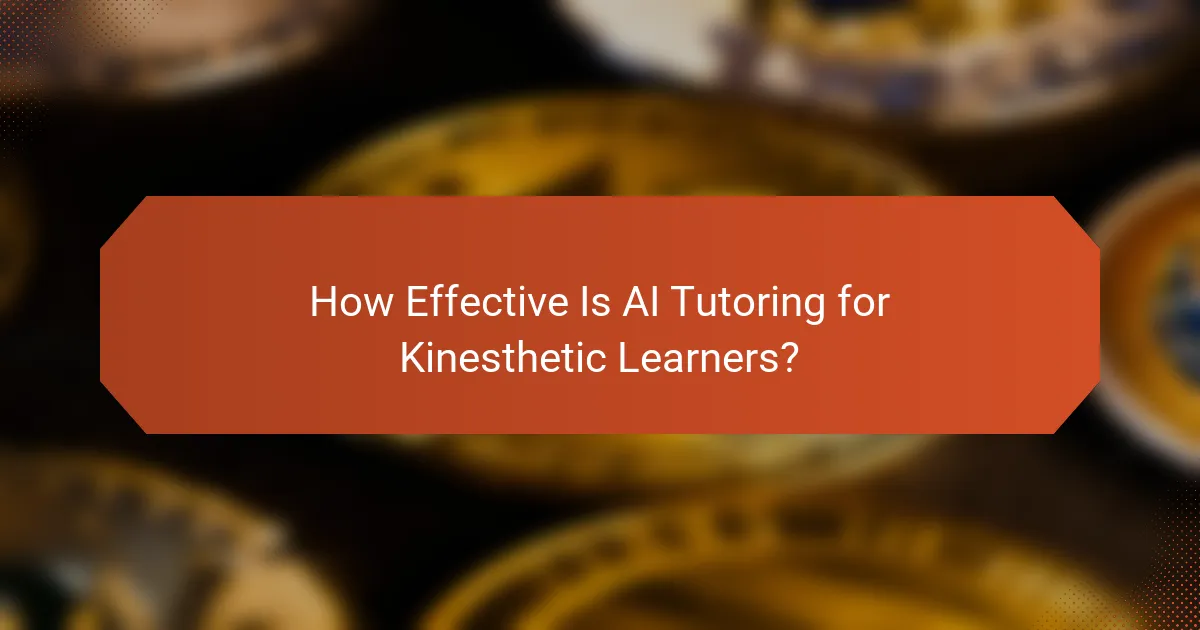
How Effective Is AI Tutoring for Kinesthetic Learners?
AI tutoring can be highly effective for kinesthetic learners by providing tailored experiences that engage their hands-on learning style. These learners benefit from interactive and practical applications of concepts, particularly in STEM subjects.
Personalized learning experiences
AI tutoring systems can adapt to the unique learning preferences of kinesthetic learners by offering customized content and pacing. This personalization allows learners to explore topics at their own speed, focusing on areas where they need the most practice.
For example, an AI tutor might adjust the difficulty of problems based on a student’s performance, ensuring that they remain challenged yet not overwhelmed. This adaptability can significantly enhance motivation and retention of information.
Interactive simulations and activities
Interactive simulations are crucial for kinesthetic learners, as they allow students to engage with material in a hands-on manner. AI tutoring platforms often incorporate virtual labs or interactive models that enable learners to manipulate variables and observe outcomes in real-time.
For instance, a student studying physics might use a simulation to experiment with different forces acting on an object, reinforcing their understanding through active participation rather than passive observation.
Real-time feedback mechanisms
Real-time feedback is essential for kinesthetic learners, as it helps them understand their mistakes and correct them immediately. AI tutoring systems can provide instant feedback on exercises, allowing students to adjust their approach without delay.
This immediate response can help reinforce learning by highlighting correct methods and guiding learners through errors, fostering a more effective learning environment. For example, if a student incorrectly applies a formula, the AI can prompt them to reconsider their steps right away.
Case studies on kinesthetic outcomes
Several case studies have demonstrated the effectiveness of AI tutoring for kinesthetic learners in STEM fields. In one study, students using an AI platform that emphasized hands-on activities showed improved test scores compared to those who relied solely on traditional methods.
Another case highlighted a group of engineering students who utilized AI-driven simulations, resulting in higher engagement levels and better understanding of complex concepts. These outcomes suggest that integrating AI tutoring with kinesthetic learning strategies can yield significant educational benefits.
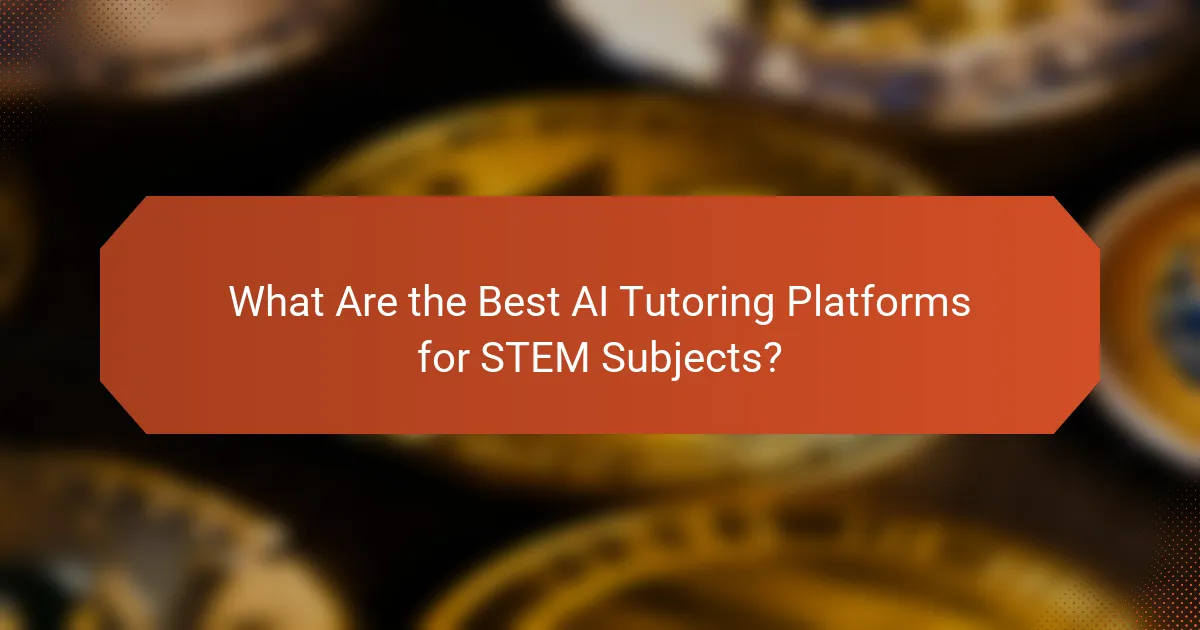
What Are the Best AI Tutoring Platforms for STEM Subjects?
The best AI tutoring platforms for STEM subjects provide personalized learning experiences, adapting to individual student needs and learning styles. These platforms often include interactive content, assessments, and progress tracking to enhance understanding and retention in complex topics.
Khan Academy
Khan Academy offers a comprehensive library of instructional videos and practice exercises across various STEM subjects, including math, science, and computer programming. Its AI-driven platform personalizes learning paths based on student performance, ensuring that learners can progress at their own pace.
Students can track their progress through dashboards that highlight strengths and areas needing improvement. The platform is free, making it accessible for learners worldwide, which is particularly beneficial for those in underserved communities.
Coursera
Coursera partners with top universities and organizations to provide high-quality courses in STEM fields. The platform uses AI to recommend courses based on user interests and previous learning experiences, allowing for a tailored educational journey.
While many courses are free to audit, obtaining a certificate typically requires a fee ranging from $30 to $200. This investment can be worthwhile for learners seeking to enhance their resumes or gain credentials in specific areas.
Edmodo
Edmodo is designed primarily for classroom use, facilitating communication between teachers and students. It includes features that allow educators to assign tasks and track student progress in STEM subjects, leveraging AI to provide insights into learning patterns.
While it is not exclusively an AI tutoring platform, its collaborative tools can enhance the learning experience by connecting students with peers and resources, making it a valuable supplement for STEM education.
Smart Sparrow
Smart Sparrow focuses on adaptive learning technologies, creating personalized learning experiences in STEM subjects. Its platform allows educators to design interactive lessons that respond to student inputs, providing immediate feedback and support.
This approach helps students engage more deeply with the material, as they can explore concepts at their own pace. Smart Sparrow often requires a subscription, which can vary based on institutional needs, making it essential for schools to evaluate its cost-effectiveness.
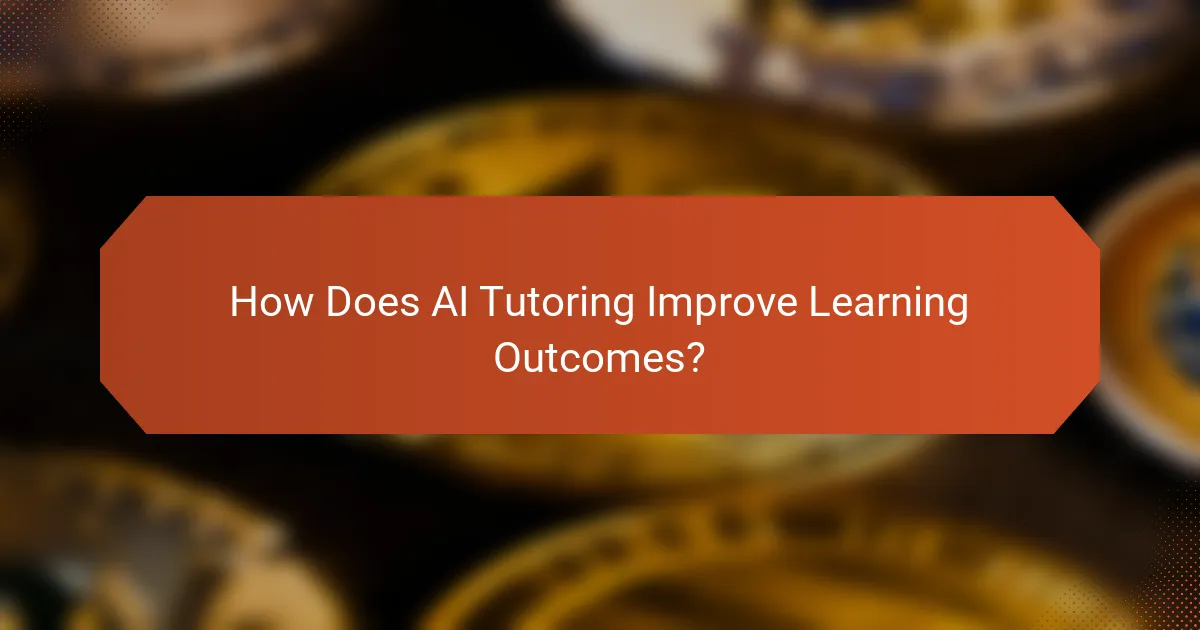
How Does AI Tutoring Improve Learning Outcomes?
AI tutoring enhances learning outcomes by providing personalized instruction tailored to individual needs, particularly for kinesthetic learners in STEM subjects. This technology adapts to students’ learning styles, offering interactive and engaging experiences that improve comprehension and retention.
Enhanced engagement and motivation
AI tutoring systems often incorporate gamification elements, making learning more enjoyable and interactive. For kinesthetic learners, this can include hands-on activities and simulations that allow them to actively participate in the learning process. Such engagement boosts motivation, encouraging students to explore subjects more deeply.
Additionally, AI can provide instant feedback, helping students see their progress in real-time. This immediate reinforcement can significantly increase their interest and investment in the material, leading to a more proactive approach to learning.
Improved retention of information
AI tutoring can enhance retention by using adaptive learning techniques that cater to a student’s unique pace and style. For example, kinesthetic learners might benefit from physical activities that reinforce concepts, such as building models or conducting experiments. This hands-on approach helps solidify knowledge through practical application.
Moreover, AI systems can revisit concepts at strategic intervals, leveraging spaced repetition to strengthen memory retention. By revisiting material over time, students are more likely to retain information long-term, which is crucial for success in STEM subjects.
Higher test scores and performance
Students who engage with AI tutoring often see improved test scores and overall academic performance. The personalized nature of AI allows for targeted practice on weak areas, ensuring that students are well-prepared for assessments. For instance, a kinesthetic learner might focus on problem-solving through interactive simulations that mirror test scenarios.
Research indicates that students using AI tutoring can achieve scores that are significantly higher than their peers who do not use such technology. This performance boost can be attributed to the tailored learning experiences that address individual challenges, making it a valuable tool in the educational landscape.
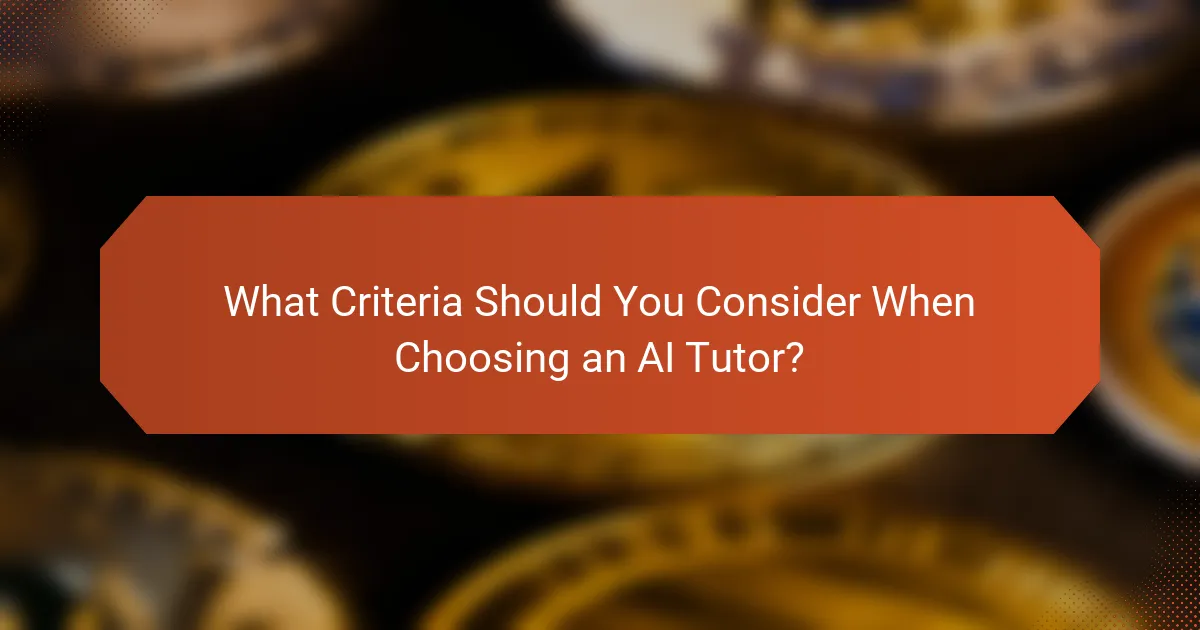
What Criteria Should You Consider When Choosing an AI Tutor?
When selecting an AI tutor, consider customization options, subject matter expertise, and user interface accessibility. These factors significantly influence the effectiveness of the tutoring experience, especially for kinesthetic learners in STEM subjects.
Customization options
Customization options allow the AI tutor to adapt to individual learning styles and preferences. Look for platforms that offer personalized learning paths, adjustable difficulty levels, and the ability to focus on specific topics or skills. For kinesthetic learners, interactive elements such as simulations or hands-on activities can enhance engagement.
Evaluate how well the AI can track progress and adjust its teaching methods accordingly. A good AI tutor should provide feedback and modify its approach based on the learner’s performance, ensuring a tailored educational experience.
Subject matter expertise
Subject matter expertise is crucial for effective tutoring, particularly in complex STEM fields. Ensure the AI tutor has a strong foundation in the relevant subjects, such as mathematics, physics, or computer science. This expertise enables the AI to provide accurate information and relevant examples.
Check if the AI tutor is aligned with current educational standards and curricula. This alignment ensures that the content is not only accurate but also applicable to what learners are studying in their courses, enhancing the overall learning experience.
User interface and accessibility
A user-friendly interface is essential for a smooth tutoring experience. The AI tutor should be easy to navigate, with clear instructions and intuitive design. Accessibility features, such as text-to-speech or adjustable font sizes, can help accommodate various learning needs.
Consider the availability of support resources, such as tutorials or help centers, which can assist users in maximizing the platform’s features. A responsive design that works well on different devices, including tablets and smartphones, is also beneficial for learners who prefer flexibility in their study environments.

What Are the Limitations of AI Tutoring for Kinesthetic Learners?
AI tutoring often falls short for kinesthetic learners who thrive on hands-on experiences. These learners typically require physical interaction and movement to grasp concepts effectively, which AI platforms may not provide.
Lack of physical interaction
The primary limitation of AI tutoring for kinesthetic learners is the absence of physical interaction. These learners benefit from engaging in activities that involve touch, movement, and manipulation of materials, which AI cannot replicate.
For instance, a kinesthetic learner studying physics might grasp concepts better through experiments involving physical objects rather than virtual simulations. Without the ability to physically engage with materials, their understanding may remain superficial.
To support kinesthetic learners, educators should consider supplementing AI tutoring with hands-on activities. This could include using physical models, conducting experiments, or incorporating movement-based learning strategies to reinforce concepts taught through AI platforms.
